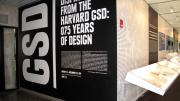When Peter Christensen, G ’14, set out to create an exhibit representing the first 75 years of the Graduate School of Design (GSD), he hit an immediate snag: how should he portray an institution that prides itself on being very much “in the present” without shortchanging the school’s rich history?
GSD dean Mohsen Mostafavi “was particularly concerned with potentially fossilizing the school in a historical exhibition that would make everything seem dusty and antiquated,” Christensen says. “There was also an aspect of making sure this was geared toward the future, so it was a challenge.”
Diving into the school’s archives, Christensen, the exhibit’s official curatorial director, discovered that GSD records were surprisingly spotty and incomplete, especially during its first 50 years. An exhibit based on the school’s chronology clearly was not an option, so what, he wondered, would his new MO be?
In the end, he decided that the best solution was to highlight 120 “journalistic dispatches from the past, each with its own narrative and artifacts.” Collaborating with more than 60 students, professors, alumni, and staff members, he created Dispatches from the GSD: 075 Years of Design, an extravagant display that’s interactive, engaging, and just plain fun.
Some “dispatches” are as small as a student’s one-semester studio project; others are large enough to cover a professor’s entire career, allowing the exhibit to “scale in and out to different spaces of time and have some more intimate, and some less intimate, portraits of the school over its 75 years,” Christensen explains.
Along with 10 graduate-student researchers and two librarians, he conducted an enormous amount of research and many archival interviews, but the dispatches, or as Christensen alternatively calls them, “episodes,” are actually historical fiction, written as headlined news stories tied to dates and places. They’re arranged in six thematic categories: Design as Research, Design as Critique, City as Process, City as Form, The Continuous Institution, and The Shifting Institution.
“The idea of the 'episode' lent an operative way of engaging this imperative of both the past and the future,” Christensen says. “We [also] sought to explore how the school dealt with external changes—political issues, changes in ideas about gender, women’s place in design, minorities, and social change. You’ll see a lot of these projects speak to these sociopolitical and international themes.”
One of the most breathtaking dispatches is the “The 1969 Protest T-shirt,” originally designed by Harvey Hacker ’63, then a master of architecture student wrapping up his studies at the GSD in the spring of 1969. Upon hearing of the “Bust,” the violent eviction of occupying students from University Hall by police officers and state troopers on April 10, Hacker and colleagues from the GSD converged in the basement of Robinson Hall (then a GSD building) and discussed what could be done.
Christensen recalls: “A troupe of students, according to Hacker, marched over to the art-supply shop in Putnam Circle and pleaded with the proprietor for a discount on equipment for silk-screening. Hacker remembers that the inquiry ‘awakened memories’ of the proprietor’s own political activity as a student in Europe and he responded, without hesitation, by saying: ‘Take what you want.’ With their equipment on loan, the students returned to Robinson Hall to teach themselves the new craft of silk-screening overnight. The students agreed upon the red fist as the symbol.”
“They identified the fact that the grievances against the administration lacked a graphic identity, describing it as a ‘graphic gap’ GSD students would be able to fill,” he adds.
Another dispatch depicts the 1961 event called “Kite Play”—a short-lived, four- or five-year tradition where students constructed kites and flew them along the Charles River—complete with black-and-white photographs. The headline reads: “Kites Take Over Cambridge Sky.”
Christensen points out that he and his team are fully aware that developing a thematic exhibition is also a way to reflect on the GSD’s position in the present, as well as future events, thoughts, and ideas.
“In some ways it’s very important for us to be in the present, but at the same time, to see the present as a historical project,” Christensen says. The dispatches’ “physical placement together, and their explication as present-tense ‘dispatches,’ I hope, offers an incisive sketch of the school’s history, seen through the lens of continuity and change.”














